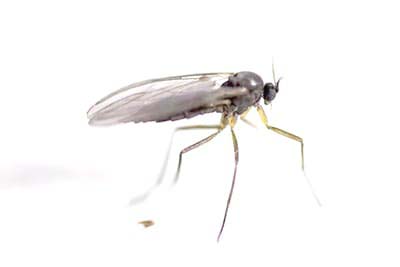Latin Name: Phoridae

Flies are one of the most prevalent pests in the home. They transmit pathogens that cause severe health crises. Phorid flies can transmit bacteria and other organisms that can affect the digestive system.
They usually undergo four developmental phases: egg, larval, pupa, and adult. They are attracted to decaying organic materials. Some of their favorite places are the sinks, seldom-used drains, and room-temperature ripened produce.
They display characteristic short and erratic flight. The adults have a habit of always running across walls, tables, TV screens, plat foliage, and windows. They are more interested in decayed plants and animals than any pests. The best way to prevent or get rid of them is to ensure proper hygiene in how you store and preserve your food. Clean your kitchen regularly and ensure proper food storage and preservation hygiene to avoid breeding flies.
Phorid flies are from the family Phoridae. They are often tiny, about 0.5 to 5.5 mm. At first glance, they almost look like fruit flies because they are known for their severely arched thorax. They are usually black or dull brown but sometimes yellow. Their head is generally round, but in some, it is narrow around the vertex. Phorid flies have dichoptic eyes; their male eyes are close, but the female is open.
The third segment of their antenna is either large and rounded or large and elongated. The proboscis is often stretched, bent at an angle, and highly sclerotized. There is a group of bristles on their head. Their wings are often tinged and clear with some markings on rare occasions. The shape and size of their antenna display sexual dimorphism.
Their larvae are often tiny, rarely over 10 mm long, and usually have 12 visible segments.
Phorid flies often breed in any material, unlike other flies that will likely stay in one place or the area with food only. They are usually found in coffins so that they can breed as crypts in coffins of buildings. They can find their breeding area in dumpsters, drains, trash containers, grease traps, garbage disposals, crawl spaces, and any site that allows decay. Phorid flies often breed in poorly stored meats and damage containers of organic-based paints and glues. Light attracts adult Phorid flies; hence during summer, lights from the patio and decks attract them to the window and doorways.
You often find them eating fungi, insects, decomposing vegetables such as onions, decomposing flour, and under equipment in kitchens and bakeries. They enjoy feeding on decaying matter, especially those that build up inside tub drains and sinks. Unfortunately, their feeding habits can cost humans their health and safety.
The first apparent sign that announces their presence is that they are flying in the house. They are often buzzing around the house and scurrying across surfaces in the home. It usually happens when there is a clogged or damaged sewer pipe, dirty garbage containers, or accumulated decaying material. Phorid flies are often called coffin flies, sewer flies, or scuttle flies because these are the places you will find them and the things they eat. Some of the things they eat are animal feces, sewage, rotting food and plants, animal carcasses, and layers of dirt accumulated at the side of drains.
Phorid flies like to lay their eggs in the nests of other pests like bees, termites, wasps, live beetles, caterpillars, and millipedes. When the larvae hatch, they feed on their host.
These insects spend most of their time on decaying organisms; hence, they often have bacteria and pathogens attached to their body. This way, it can spread disease to people in the house.
They are also found breeding and developing in pumping pipes. At some point, they may get too much that they can’t be removed without a home, causing a severe pumping leak.
The best way to control the infestation of phorid flies is by cleaning the home properly. This way, you will be able to eliminate where they breed. Other things you can do are:
If you suspect these pests are in or around your home, give us a call for a Free Home Inspection!
